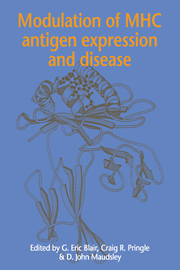Book contents
- Frontmatter
- Contents
- List of contributors
- Preface
- List of abbreviations
- 1 General introduction to the MHC
- 2 Organization of the MHC
- 3 Interactions of cytokines in the regulation of MHC class I and class II antigen expression
- 4 Control of MHC class I gene expression
- 5 Control of MHC class II gene expression
- 6 Modulation of MHC antigen expression by viruses
- 7 Modulation of MHC antigen expression by retroviruses
- 8 Modulation of MHC class I antigen expression in adenovirus infection and transformation
- 9 MHC expression in HPV-associated cervical cancer
- 10 Inhibition of the cellular response to interferon by hepatitis B virus polymerase
- 11 Cellular adhesion molecules and MHC antigens in cells infected with Epstein-Barr virus: implications for immune recognition
- 12 Effect of human cytomegalovirus infection on the expression of MHC class I antigens and adhesion molecules: potential role in immune evasion and immunopathology
- 13 Oncogenes and MHC class I expression
- 14 Mechanisms of tumour cell killing and the role of MHC antigens in experimental model systems
- 15 Manipulation of MHC antigens by gene transfection and cytokine stimulation: a possible approach for pre-selection of suitable patients for cytokine therapy
- 16 Overexpression of MHC proteins in pancreatic islets: a link between cytokines, viruses, the breach of tolerance and insulindependent diabetes mellitus?
- 17 The role of cytokines in contributing to MHC antigen expression in rheumatoid arthritis
- 18 Expression of an MHC antigen in the central nervous system: an animal model for demyelinating diseases
- Index
5 - Control of MHC class II gene expression
Published online by Cambridge University Press: 11 September 2009
- Frontmatter
- Contents
- List of contributors
- Preface
- List of abbreviations
- 1 General introduction to the MHC
- 2 Organization of the MHC
- 3 Interactions of cytokines in the regulation of MHC class I and class II antigen expression
- 4 Control of MHC class I gene expression
- 5 Control of MHC class II gene expression
- 6 Modulation of MHC antigen expression by viruses
- 7 Modulation of MHC antigen expression by retroviruses
- 8 Modulation of MHC class I antigen expression in adenovirus infection and transformation
- 9 MHC expression in HPV-associated cervical cancer
- 10 Inhibition of the cellular response to interferon by hepatitis B virus polymerase
- 11 Cellular adhesion molecules and MHC antigens in cells infected with Epstein-Barr virus: implications for immune recognition
- 12 Effect of human cytomegalovirus infection on the expression of MHC class I antigens and adhesion molecules: potential role in immune evasion and immunopathology
- 13 Oncogenes and MHC class I expression
- 14 Mechanisms of tumour cell killing and the role of MHC antigens in experimental model systems
- 15 Manipulation of MHC antigens by gene transfection and cytokine stimulation: a possible approach for pre-selection of suitable patients for cytokine therapy
- 16 Overexpression of MHC proteins in pancreatic islets: a link between cytokines, viruses, the breach of tolerance and insulindependent diabetes mellitus?
- 17 The role of cytokines in contributing to MHC antigen expression in rheumatoid arthritis
- 18 Expression of an MHC antigen in the central nervous system: an animal model for demyelinating diseases
- Index
Summary
Introduction
The MHC class II (also known as immune response-associated antigens, or Ia) genes are a multigene family encoded on chromosome 6 in humans (Fig. 5.1) and chromosome 17 in mice (see Chapter 2). The functional role of the MHC class II antigens in the immune response is described extensively in Chapters 1 and 3. This includes their function in antigen presentation, thymic education and T cell recognition/activation, their contribution to transplant acceptance or rejection, their genetic association with diseases, their aberrant up-regulation in a number of autoimmune and inflammatory diseases as well as their absence in specific immunodeficiencies. The involvement of MHC class II gene products in a large number of clinical conditions confers practical importance to the study of their regulation. Furthermore, the tissue-, cellspecific, differentiation-dependent and cytokine-regulated expression of MHC class II genes represent features that have made these genes a model system to study gene regulation. In this chapter, the expression and regulation of MHC class II genes in normal and disease states will be discussed, as well as the molecular basis for the constitutive and inducible modes of class II gene regulation.
Role of the MHC class II antigens in the immune response
The specificity of the immune system is conferred by the binding of foreign antigens through receptors on the surfaces of B and T lymphocytes, the immunoglobulin (Ig) molecule and the T cell receptor (TCR), respectively.
- Type
- Chapter
- Information
- Modulation of MHC Antigen Expression and Disease , pp. 103 - 132Publisher: Cambridge University PressPrint publication year: 1995



